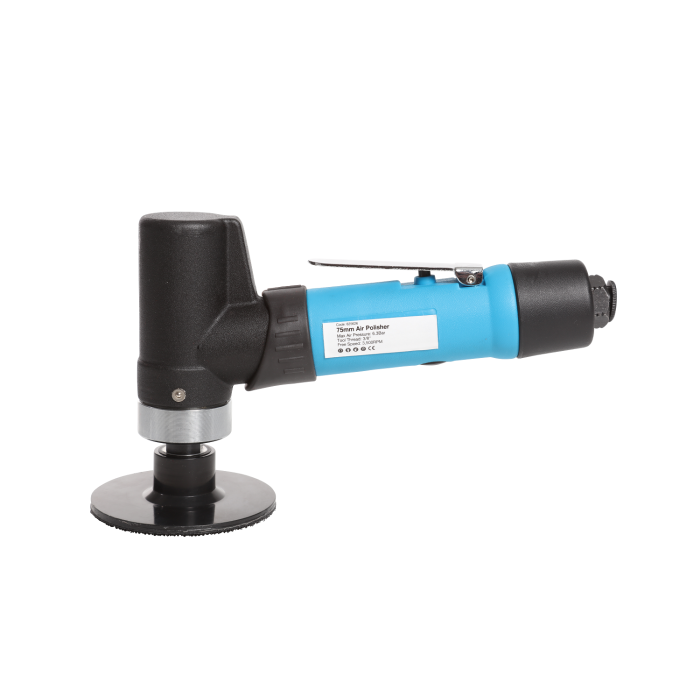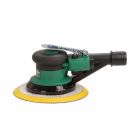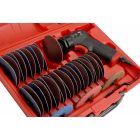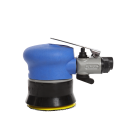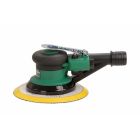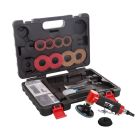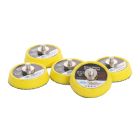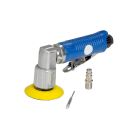| Why use a 75mm air operated angle sander |
| A 75mm air operated angle sander is specifically designed for precision sanding and surface preparation tasks where compact size, control, and consistent performance are essential. |
| The small 75mm (3-inch) sanding pad allows easy access to tight spaces, curves, edges, and small repair areas that are difficult to reach with larger sanders. |
| |
| Being air-powered (pneumatic), this sander delivers steady speed and high torque without overheating during extended use, making it ideal for professional environments such as automotive body shops, marine repair, metal fabrication, and industrial maintenance. |
| Air operation also makes the tool lighter and easier to handle compared to electric models, reducing user fatigue, especially during prolonged overhead or vertical work. |
| |
| The angle design gives better ergonomic control, allowing precise handling on awkward surfaces and complex geometries, which improves surface quality and reduces the risk of over-sanding or damaging surrounding areas. |
| |
| This type of sander is well-suited for spot repairs, paint preparation, feather edging, sanding welds, and fine surface blending, across metals, composites, plastics, and wood. |
| |
| |
| The benefits of using a 75mm air operated angle sander |
| |
| 1. Precision Access to Tight Areas |
| |
| The compact 75mm (3-inch) size allows for sanding in tight spaces, on edges, around curves, and on small panels where larger sanders are too bulky. |
| |
| 2. Lightweight and Ergonomic Design |
| |
| Being air-operated, the sander is lightweight and easy to control, reducing user fatigue and enabling comfortable operation over long periods, including vertical or overhead work. |
| |
| 3. Consistent Speed and Power |
| |
| Pneumatic operation ensures steady torque and speed without the risk of overheating, even during continuous or heavy-duty use. |
| |
| 4. Angle Head for Better Control |
| |
| The angled design offers improved ergonomics, allowing better access to awkward surfaces and providing more precise handling during detailed sanding tasks. |
| |
| 5. Versatility Across Materials |
| |
| Suitable for use on metal, plastic, fiberglass, composites, and wood, making it a flexible tool for a wide range of industries including automotive, marine, industrial, and woodworking. |
| |
| 6. Ideal for Spot Repairs and Fine Surface Preparation |
| |
| Perfect for feather edging, blending paint repairs, sanding small welds, and prepping surfaces for coatings, ensuring a high-quality finish. |
| |
| 7. Durability for Professional Use |
| |
| Air tools are built for heavy-duty, long-term use with less risk of motor burnout compared to electric sanders, making them highly durable investments for professional shops. |
| |
| 8. Quick Material Removal with Controlled Finishing |
| |
| Provides the ability to remove material efficiently while still maintaining fine control over the finish, reducing the need for excessive touch-ups or rework. |
| |
| |
| Uses and applications of a 75mm air operated angle sander |
| |
| 1. Automotive Body Repair and Refinishing |
| |
| Use: Feather edging paint, blending clear coat edges, spot repairs, and sanding small panels. |
| |
| Application: Collision repair centers, car restoration projects, custom paint shops. |
| |
| 2. Industrial Surface Preparation |
| |
| Use: Smoothing welds, sanding metal surfaces, preparing small parts for coating or painting. |
| |
| Application: Fabrication shops, machinery maintenance, industrial equipment refurbishment. |
| |
| 3. Marine and Boat Maintenance |
| |
| Use: Sanding gelcoat repairs, prepping fiberglass surfaces, smoothing small areas on hulls and decks. |
| |
| Application: Boat yards, marine service companies, yacht maintenance. |
| |
| 4. Aerospace and Aviation Maintenance |
| |
| Use: Fine surface preparation on small aircraft panels, composites, and tight structural areas. |
| |
| Application: Aircraft maintenance, aerospace manufacturing, aviation refinishing shops. |
| |
| 5. Woodworking and Cabinetry |
| |
| Use: Sanding detailed wood surfaces, finishing furniture edges, and prepping small surfaces between coats. |
| |
| Application: Furniture making, fine woodworking, cabinetry, and restoration projects. |
| |
| 6. Plastic and Composite Finishing |
| |
| Use: Sanding plastic components, fiberglass panels, and composite surfaces without overheating. |
| |
| Application: Automotive aftermarket parts, marine composites, sporting goods manufacturing. |
| |
| 7. Motorcycle and Powersports Repair |
| |
| Use: Prepping tanks, fenders, fairings, and other tight areas for painting or clear coating. |
| |
| Application: Motorcycle restoration, custom bike building, ATV and UTV repair. |
| |
| 8. Hobby and DIY Projects |
| |
| Use: Sanding small items, finishing model parts, restoring vintage items, and spot repairs on home projects. |
| |
| Application: Home workshops, model makers, DIY enthusiasts. |



